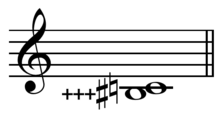
Back Coma (música) Catalan Koma (hudba) Czech Komma (Musik) German Coma (música) Spanish Komma Estonian کما (موسیقی) Persian Komma Finnish Comma (musicologie) French Komao IO Comma (musica) Italian


In music theory, a comma is a very small interval, the difference resulting from tuning one note two different ways.[1] Strictly speaking, there are only two kinds of comma, the syntonic comma, "the difference between a just major 3rd and four just perfect 5ths less two octaves", and the Pythagorean comma, "the difference between twelve 5ths and seven octaves".[2] The word comma used without qualification refers to the syntonic comma,[3] which can be defined, for instance, as the difference between an F♯ tuned using the D-based Pythagorean tuning system, and another F♯ tuned using the D-based quarter-comma meantone tuning system. Intervals separated by the ratio 81:80 are considered the same note because the 12-note Western chromatic scale does not distinguish Pythagorean intervals from 5-limit intervals in its notation. Other intervals are considered commas because of the enharmonic equivalences of a tuning system. For example, in 53TET, B![]() ♭ and A♯ are both approximated by the same interval although they are a septimal kleisma apart.
♭ and A♯ are both approximated by the same interval although they are a septimal kleisma apart.
- ^ Waldo Selden Pratt (1922). Grove's Dictionary of Music and Musicians, Vol. 1, p. 568. John Alexander Fuller Maitland, Sir George Grove, eds. Macmillan.
- ^ Clive Greated (2001). "Comma", Grove Music Online. doi:10.1093/gmo/9781561592630.article.06186
- ^ Benson, Dave (2006). Music: A Mathematical Offering, p. 171. ISBN 0-521-85387-7.
© MMXXIII Rich X Search. We shall prevail. All rights reserved. Rich X Search